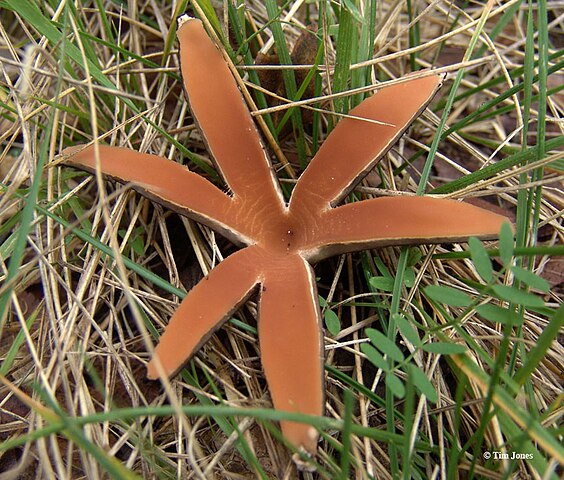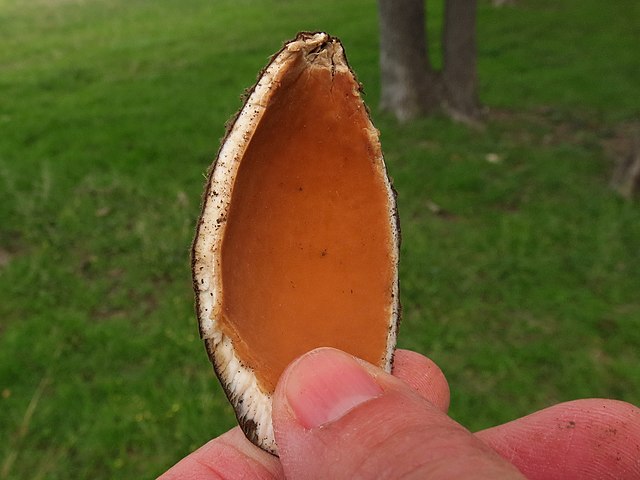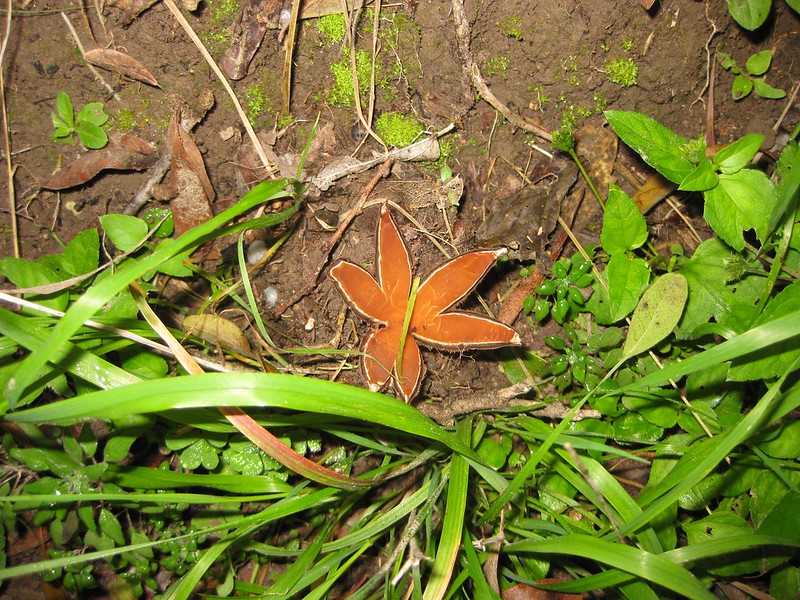Chorioactis geaster, known as the Devil’s Cigar, is a rare and unique mushroom found primarily in Texas and Japan. Its striking transformation from a dark, cigar-shaped capsule to a star-shaped structure has fascinated mycologists and nature enthusiasts alike.

What Is Chorioactis geaster Mushroom?
Chorioactis geaster, commonly known as the Devil’s Cigar, is a unique and rare fungus. It has intrigued mycologists and mushroom enthusiasts for decades due to its unusual appearance and limited geographic distribution.
Found primarily in Texas, USA, and a few locations in Japan, this mushroom stands out for its distinctive star-shaped fruiting body. The fungus emerges from decaying wood, and its peculiar shape, color, and scarcity have earned it a mythical status among those who study fungi.
The Devil’s Cigar initially appears as a dark brown to blackish, elongated capsule that resembles a cigar, hence its common name.
As it matures, the capsule splits open from one end, revealing an interior lined with spore-producing tissue. The opened structure takes on a striking star shape, typically with 4 to 7 arms, which further enhances its unique appearance.
How You Can Identify The Devil’s Cigar?
To accurately identify this fascinating fungus, pay attention to the following key features:
Color and Shape
The immature fungus has a dark, cylindrical form that looks very much like a cigar. As it matures and splits open, the mushroom transforms into a star-shaped structure.
The stark contrast between its closed and open forms makes it one of the most easily recognizable fungi.

Habitat
You can find Chorioactis geaster on decaying hardwood stumps and roots. It favors damp, decomposing wood, which provides the necessary nutrients for its growth.
In Texas, it typically appears in wooded areas, often in shaded, moist environments.
In Japan, it thrives in similar habitats, making these decaying woodlands the prime locations to spot this rare mushroom.
Size
The cigar-shaped capsule can reach up to 12 cm in length before splitting. When it opens, the star-shaped structure can span several centimeters across, depending on how many arms it develops.
The size can vary slightly based on environmental conditions, but the elongated initial form and subsequent star shape remain consistent identifiers.
Seasonality
In Texas, the Devil’s Cigar typically appears from late fall to early winter. This period corresponds with cooler, wetter weather, which is ideal for fungal growth.
In Japan, it can be found from late summer to fall, aligning with the country’s specific climatic conditions that support its development.
The seasonal appearance makes it easier to plan excursions to spot this rare fungus.
Additional Tips
Look for this mushroom in areas that have been undisturbed for a while, where decaying wood is abundant.
Pay close attention to fallen logs and old stumps, and don’t be afraid to gently move leaves or debris that might be covering potential growth sites.
The striking contrast of the dark, cigar-like capsule against the earthy tones of decaying wood can help you spot it more easily.
When you encounter a fungus that fits these descriptions, take a closer look at its structure.
The dramatic transformation from a closed capsule to an open star is not just a visual treat but a definitive sign you have found Chorioactis geaster.
Always remember to document your findings with photographs and notes on the location and conditions, as this can contribute valuable information to mycological studies and conservation efforts.
Is Chorioactis Geaster Edible?
Chorioactis geaster is not considered edible. Despite its intriguing appearance, the mushroom has no known culinary value. Unlike many other fungi, the Devil’s Cigar does not feature in traditional or contemporary cuisine.
The texture and composition of the mushroom make it unappealing for consumption. Furthermore, there is limited information on its nutritional properties, if any, making it a risky choice for foraging.
Is Chorioactis Geaster Psychedelic?
No, Chorioactis geaster is not psychedelic. This mushroom does not contain any psychoactive compounds known to induce hallucinations or alter consciousness.

The Devil’s Cigar is primarily of interest to mycologists due to its rarity and unique morphology, not for any mind-altering effects. Unlike some other fungi that have gained notoriety for their psychoactive properties, Chorioactis geaster holds no such allure.
Chorioactis Geaster Etymology Explained
The name “Chorioactis geaster” derives from Greek and Latin roots. The genus name “Chorioactis” combines “chorio-” (meaning “skin” or “covering” in Greek) and “actis” (meaning “ray” or “beam” in Greek), referring to the star-like rays that appear when the mushroom splits open. The species name “geaster” comes from “geo” (earth) and “aster” (star), reflecting its star-shaped appearance when viewed from above.
The common name, Devil’s Cigar, likely originates from its initial cigar-like form and the way it dramatically splits open, which might have evoked imagery of something sinister or otherworldly to those who first encountered it. This dramatic transformation, coupled with the mushroom’s rarity, adds to its mystique and the fittingly dark moniker.
Conservation and Cultural Significance
Chorioactis geaster is not just a biological curiosity; it holds significant cultural and ecological value. Due to its rarity and limited distribution, conservation efforts are crucial to ensure its survival. In Texas, the Devil’s Cigar is considered a symbol of regional biodiversity, highlighting the importance of preserving native species and their habitats.
In Japan, the fungus is a natural marvel, with sightings often becoming local news. The Japanese revere their natural phenomena, and Chorioactis geaster fits into this tradition of respecting and marveling at the unusual and rare occurrences in nature.
Research and Scientific Interest
Scientists are particularly interested in Chorioactis geaster because of its unique morphology and limited distribution. Studying this mushroom can provide insights into fungal evolution, biogeography, and ecology. Researchers analyze its genetic makeup to understand how such a distinctive and isolated species fits into the larger fungal kingdom. Additionally, its ability to thrive in specific, often decayed, wood habitats offers clues about ecosystem dynamics and the role of fungi in nutrient cycling and wood decomposition.
How to Spot Chorioactis geaster in the Wild
For those eager to spot this rare fungus, patience and a bit of luck are required. Begin your search in the right habitats during the appropriate seasons. In Texas, search the damp, decaying woodlands from late fall to early winter. Look for old hardwood stumps or roots that show signs of decay. In Japan, late summer to fall is the prime time, especially in similar decaying wood habitats.
Join local mycological societies or online forums to connect with other enthusiasts who may have sighting tips or can offer guidance. Always remember to respect the natural habitat and follow ethical foraging practices, ensuring that this rare species continues to thrive in its limited environments.
Conclusion
Chorioactis geaster, the Devil’s Cigar, is a fascinating mushroom that captivates those who discover it. Its unique appearance, rare distribution, and dramatic transformation from a cigar-like capsule to a star-shaped structure make it a true wonder of the fungal world.
While not edible or psychedelic, its ecological and cultural significance underscores the importance of preserving such unique species. Whether you are a mycologist, a nature enthusiast, or simply someone who appreciates the oddities of the natural world, Chorioactis geaster offers a remarkable glimpse into the diversity and mystery of fungi.


